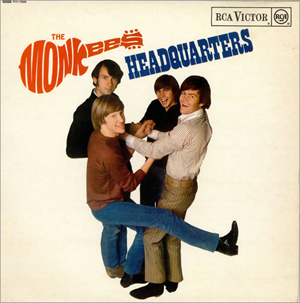
Headquarters by The Monkees (1967)
I recently moved out of my old apartment, and as I was packing my stuff away into boxes, I found myself in need of some good music. "A-ha," I thought, "a perfect opportunity to tear the cellophane off of that nifty Monkees five-CD set that I've been saving for just such an occasion." The CD set in question contains remastered versions of the Monkees' first five albums. I had listened to all those albums when I was young, but never owned any of them on CD. When I found the set at the music store, it felt like hitting the jackpot.
As I continued sorting through piles of junk, I began listening to the CDs in chronological order. The first two albums are excellent, but it was Headquarters, their third, which really stood out as interesting. The album didn't appeal to me much when I first listened to it back in the mid-80s. I was a big fan of The Monkees at the time, but I liked their other albums more than Headquarters, which seemed to be one of their lesser efforts.
After my recent re-listening, I still don't consider this album to be their best (that honor goes to their fourth album, Aquarius, Capricorn, Pisces, and Jones), but I have developed a new appreciation for it. The most striking thing about it is the contrast between the somber mood that pervades it and the band's silly TV-show image. This is probably the band's least happy album, which explains why it wasn't a favorite in my younger days. It explores the dark side of life, and is full of songs about disappointments and failed relationships, such as "You Told Me," "Forget that Girl," "Shades of Gray," and "Early Morning Blues and Greens." These were not the mindless, goofy pop songs that people associated with the TV band, and maybe that was the point.
It is well known that at this time in their career The Monkees wanted to write more of their own songs and play the musical instruments on their albums. A typewritten note from the band on the back of the Headquarters album cover makes it clear that this work represents their attempt to ditch the "fake band" label and establish themselves as legitimate musical artists: "We aren't the only musicians on this album, but the occasional extra bass or horn player played under our direction, so that this is all ours." Well, it wasn't exactly all theirs. Over half of the songs on the album were written by outsiders like Boyce and Hart, but this was the first Monkees album to include compositions by three of the four band members.
The album begins with the Mike Nesmith song "You Told Me," which establishes the disillusioned mood nicely: "You told me you'd always stay... You told me you'd never stray." This album, which contains three of his originals, really sees Nesmith coming into his own as a mature, talented songwriter. (As of this writing, he has released 13 studio albums as a solo artist since the breakup of The Monkees.) Elsewhere on the album's first side he becomes more upbeat and hopeful toward his love prospects on "You Just Might Be the One," but the inclusion of the word "might" keeps things from getting too optimistic.
The first half of the Headquarters album consists almost entirely of love songs, with the exception of the philosophical "Shades of Gray" (no connection to the beloved book series, thankfully) and a 41-second humorous interlude called "Band 6." All of the other tracks find the band lamenting failed relationships or looking forward to new ones. The mood throughout this first half of the album is surprisingly subdued. Whether this was intentional or not is a question for the ages. The melancholy tone seems to parallel the songwriting phase the Beatles went through shortly before they stopped touring, which resulted in albums like Help! and Beatles for Sale (or the American versions, Beatles '65 and Beatles VI).
The second track, a love song called, "I'll Spend my Life with You," although lyrically hopeful, sounds lifeless enough to be traditional church music, a mood which occurs again in "Shades of Gray." The third song, "Forget that Girl," written by producer Douglas Farthing Hatlelid, conveys the sadness of a one-sided love affair. The lyricist advises a heartbroken friend to cut his losses and move on, or maybe he's just talking to himself in the mirror. Hey, we've all done it, let's be honest here.
The band gets more eclectic and upbeat on the second half of Headquarters, starting with Peter Tork's counter-cultural anthem "For Pete's Sake." This is one of my favorite songs on the album, and features a nice 60s-style groove and an inventive chord progression. It was used as the closing music on their TV show. A message which celebrates peace and social change is conveyed in lyrics like "We were born to love one another," and "In this generation, we will make the world shine."
Another favorite is the strangely beautiful "Early Morning Blues and Greens," featuring a double-tracked lead vocal by Davy Jones. The lyrics describe the thoughts of a man sitting from sunrise to sunset in contemplation, possibly under the influence of something besides just his coffee. The loungey song arrangement, which includes trippy organ solos and echoing cymbal crashes, foreshadows the band's full descent into psychedelia on their following album, Aquarius, Capricorn, Pisces, and Jones.
The upbeat "Sunny Girlfriend," with its jangling 12-string guitar and tight vocal harmonies, shows the influence of The Byrds on Nesmith's songwriting. In lyrics like "She owns and operates her own sunshine factory" and "She can make you slow while making your mind move fast," he seems to imbue his incandescent lady with superhuman qualities. This leads one to wonder if she is real or merely a product of wishful thinking.
The album closes with the Micky Dolenz composition, "Randy Scouse Git," which delivers an anti-establishment punch as powerful as anything by the British invasion bands the Monkees emulated. The song begins with the playful dixieland rhythms of the verse, and surreal Bob Dylan-influenced lyrics. Dolenz scats deliriously during the bridge before bursting into the last defiant chorus, which mocks the expectations of society and authority figures.
Headquarters, while not quite a masterpiece, is a fascinating and vital part of the Monkees' discography, in which the band members struggled to prove their critics wrong and be taken seriously as musicians and songwriters.
Reviewed by Somebody 11/16/13
See more Favorite Albums of the Moment





